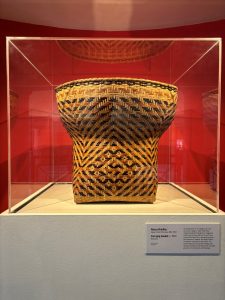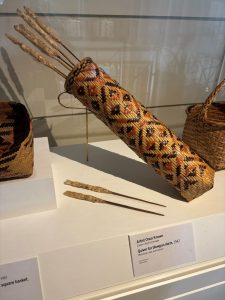
TULSA, Okla. – Interwoven: Cherokee, Muscogee (Creek), & Yuchi Baskets opened October 4, 2025 at the Philbrook Museum of Art near downtown Tvlse, Oklahoma. Curated by Welana A. Queton (Osage/Muscogee/Cherokee Nation), Mellon Fellow for Native Art at Philbrook, Interwoven exemplifies the artistry and history of these three Southeastern tribes’ ancestral basketmaking.

Arranged along the walls of the circular mezzanine, basket displays lead viewers around the exhibition, a route reminiscent of a basket-maker weaving their reed around each basket spoke. Southeastern tribes have practiced basketmaking for thousands of years. Carried along through time and turmoil, this ancestral artistry marks a line of cultural continuance through today’s basket makers.
Baskets in the exhibition range from the late 1800s to the present day. Made from natural plant materials, such as rivercane and honeysuckle, these baskets are food-safe. They are of a style often used in food processing, as shown by four baskets used for catching, sieving, sifting, and winnowing grains. Seen as “gifts from the land,”as told by the Cherokee Creation Story cited in the gallery text, baskets are valued as a source of sustenance and for their practical and functional uses. Although each tribe’s basketry differs in heritage and history, all are Interwoven in the Muscogee (Creek) town Tvlse, the city now known as Tulsa. The Cherokee, Muscogee (Creek), and Yuchi were all forcibly removed from their Southeastern homelands, and their current boundaries converge in Tulsa County (along with the Osage Nation). This exhibition of their basketry showcases a shared cultural and historical landscape.

Links
- Philbrook Website, Interwoven: Cherokee, Muscogee (Creek), & Yuchi Baskets
- Instagram, Philbrook Museum of Art
